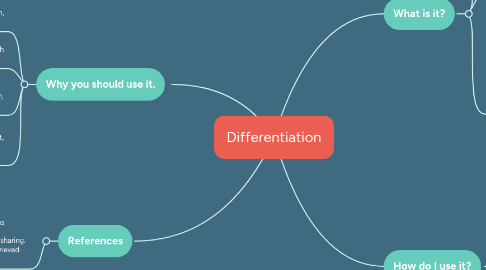
1. References
1.1. Tomlinson, C. A. (2009). Intersections between differentiation and literacy instruction: Shared principles worth sharing. The NERA Journal, 45(1), 28-33. Retrieved October 14, 2017.
2. Why you should use it.
2.1. "Students differ as learners" (Tomlinson, 2009, p. 28)
2.1.1. Not all students learn the same way and the same time in their life.
2.2. "Teachers must study their students to teach them well" (Tomlinson, 2009, p. 29)
2.2.1. Teachers have to realize how their students learn best, and make sure lessons are designed for their needs.
2.3. "Effective teachers teach up" (Tomlinson, 2009, p. 29)
2.3.1. Teachers need to believe that all of their students can show growth! Hold your students to high expectations, and if you believe, they will rise to those expectations.
2.4. "Responding to student readiness, interest, and learning profile enhances student success" (Tomlinson, 2009, p. 31)
2.4.1. Consider your students' prior knowledge and scaffold them to the next level (independent, instructional, frustrational)
3. What is it?
3.1. Using multiple approaches to teach individual students or small groups (Tomlinson, 2009).
3.2. Differentiation is meeting students at their level, and providing them with the support that they need in order to show growth.
3.3. Enjoy this video of Gerry Brooks explaining differentiated instruction :)
4. How do I use it?
4.1. MATH
4.1.1. I use differentiation in math by giving a pre-test at the beginning of each chapter and group my students to be able to start guided math groups. I teach a whole group math lesson and utilize guided math. My math groups fluctuate frequently based of different formative assessments over specific skills being taught in the whole group lesson.
4.2. READING
4.2.1. I use differentiation in reading by using the Balanced Literacy Model. I teach a whole group reading lesson, but them I break my student into small reading groups based on their current reading level. In group, I am able to give them the support that they need in order to grow as readers.
